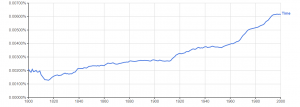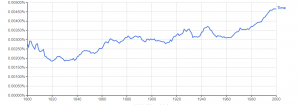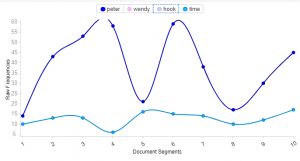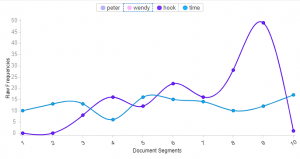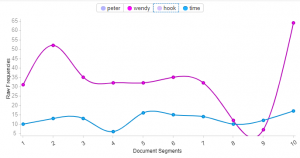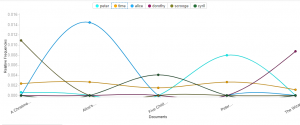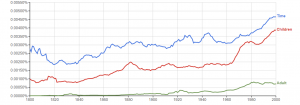Method:
I returned to the first text I analyzed, in the beginning of my Voyant adventure, J. M Barrie’s Peter and Wendy, and with my initial observations in mind, I tried to find other patterns. After cleaning up the file, and entering the text into the Voyant tool, I looked at the Cirrus Cloud and tried to determine any other words that stood out in frequency. Of course, the names of the main characters had the largest word count, but another word in particular that caught my eye was “time”. Out of curiosity, I chose to see the relationship between “time” and all the names of the main character. 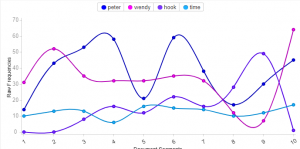
Peter, Wendy, Hook, and Time
When I saw the correlations it led me to think of other novels similar to Peter Pan and Wendy. By similar, I mean that the novel had elements of fantasy but was also popular amongst children. I then came across the texts: Alice’s Adventures in Wonderland, The Wizard of Oz, Five Children and It, and A Christmas Carol. With this new corpus, I again looked at the corpus and saw that the more prominent words were the main characters names, but that the word “time” had a significant number as well. With those factors in mind, I inputted the main characters names from all five books, and the word “time” to see what inquiries may arise.
On Google Ngram, I first inputted the word “time”, and I compared the graphs for American English and British English.
Process:
When looking at the singular text of Peter Pan and Wendy, I saw interesting implications for the characters and their relationship with time. For the main character Peter, the graph suggests that he has no concern with time since the lines do not intersect. On the other hand, the graphs for Hook and Wendy showed intersecting points between the lines. What I found interesting, is that Hook’s graph showed a positive relationship between the two lines until the downfall. His graph also had the most intersecting points. Wendy had two intersecting points but no real concrete relationship. With these observations, I questioned whether age played a factor in a character’s relationship with time. It could be since Peter and Wendy are children, time is not a big issue to them. As children they do not pay attention to how much time they will spend doing something or what time it is in the day, instead they focus on the activity and say for themselves when something should end or begin. Especially, Peter. But, for Hook, being older, he uses it more for his convenience. He might use the time to say when to travel somewhere, or when to start a mission. Or, as do most people, use it as a tool to stay organized.
Hook and Time
Moving on to the corpus of books, I played around some more with the theme of time and the relationship it had with the main characters of each book. While there was no obvious trend, I still found it interesting to see how time was still a constant variable in the texts. All of the graphs had at least intersecting points with the “time” line. Although, it could just be a signifier for the beginning and end of the adventures of the characters.
Corpus of Books
For the Google Ngram data, I thought that it was interesting to see the difference in the graphs of time in American and Britain English. It seems that in American English the trend for “time” was slow but it steadily increased. While for British English it has tiny fluctuations but is still trending in a positive direction. I also looked at the words “children” and “adult” to see if they had any correlation with each other. In American English, the lines trends for “time” and “children” share a similar upward trend starting around the 1870’s, and continues on into the 2000’s. For British English, there is a positive line but no intersections in any of the lines. However, in both graphs the line for adults is low. I’m not quite sure if this is significant or not, but it could imply how some stories in American English focuses on them of time with children and the stories in British English do not share that same attribute.
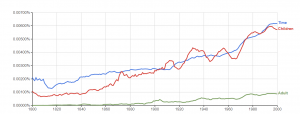
Time, Children, and Adult in American English
Time, Children, and Adult in British English
Reflection:
From doing this algorithmic criticism, it allowed me to look at the text in a different, nontraditional literary way. These tools led me to patterns, that may have taken me longer to notice had I read the whole book. But I also think by not reading the book, hindered my ability to fully extrapolate as much data as I could have. While I know the general story of Peter and Wendy, I am not as aware of other important details that could have helped me understand the data more. Yet, from my limited understanding, I gained some knowledge about the characters and their relationship to each other, and also their relationship with the concept of time.
Overall, I believe that there is merit to algorithmic criticism, there are real data and analysis that can be derived from doing a project like this; however, I also think that this type of project also takes time. Time to become an expert with all the different algorithmic tools, and graphs, as well as time to sit down and input and analyze all that data. I can see how the convenience and efficiency of this program draws in curious eyes, but because of all the information overload– and the time needed to establish this project–, it might also turn some people away.
